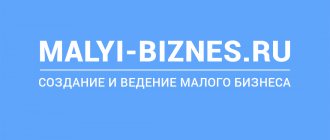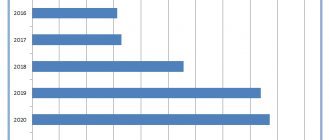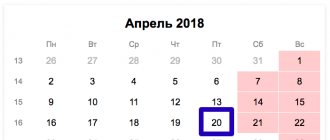New reporting form for 2021 for all employers
With the beginning of 2021, insurance premiums, which were previously managed by extra-budgetary funds, were transferred under the control of the tax authorities.
Reports on the calculation of contributions are now submitted to the Federal Tax Service, and funds have begun to be transferred there to pay them. However, a number of issues remained with the funds. The Pension Fund of Russia retains the following functions:
- acceptance of reports on employees;
- checking the accrual and payment of contributions for periods up to 2017;
- adoption of reporting on length of service that has become separate from information on the calculation of contributions;
- acceptance of adjustments based on personal information already recorded in the fund;
- acceptance of personal information submitted for the first time for periods before 2017.
The reporting specified in the last three paragraphs of this list did not become fundamentally new for the Pension Fund of Russia, but required the creation of new forms, since previously it should have been submitted as part of those types of reporting that have become invalid since 2021.
The new forms were approved by Resolution of the Pension Fund Board of December 6, 2018 No. 507p:
- SZV-STAZH - according to length of service;
- SZV-KORR - for corrections;
- SZV-ISKH - based on information not submitted on time.
Together with these forms, another one was introduced (EFV-1), which is a document combining:
- information about the policyholder;
- information on the types and number of reports submitted for each of the above types.
That is, the EDV-1 form turned out to be an accompanying document drawn up when submitting to the Pension Fund a set of each of the above reports of the same type for the same period.
Section 6. Information on paid insurance premiums (for reporting periods 2010-2013)
The section provides information on insurance premiums paid only for the reporting periods 2010-2013.
In the fields “For insurance pension”
and
“For funded pension”,
data on the amounts of insurance premiums paid in the last 3 months of the reporting period are indicated (for the reporting periods of 2010 - in the last 6 months).
Attention! When filling out these fields, you should take into account the amounts of advance payments. In this case, the amount of overpaid insurance premiums is not taken into account.
When is it necessary to submit the SZV-ISH form?
Who takes the SZV-ISH and when? SZV-ISH - new reporting for all employers who, after the end of 2021, have identified facts of failure to submit personal information on any person (persons) for periods before 2021. It will have to be submitted to the Pension Fund together with the EDV-1 form.
These reports must be prepared and submitted if it is discovered that there is a need to provide unsubmitted information. Otherwise, the fact of their failure will most likely be revealed by the fund during an audit. There are no specific deadlines for filing an SZV-ISH.
For failure to provide information about the length of service, the fund itself has the right to impose a fine (500 rubles for information on each of the insured persons - Article 17 of Law No. 27-FZ of April 1, 1996). If underpayment of contributions is also revealed, then the decision on punishment for it will be made by the Federal Tax Service according to the rules contained in the Tax Code of the Russian Federation, upon the proposal of the Pension Fund.
Read more about how responsibility for violations regarding personal reporting has been redistributed here.
Is it necessary to take SZV-ISH with SZV-STAZH? No, these two reports are not related to each other. SZV-STAZH is dedicated to data generated only by length of service annually for each year that has passed since 2016. And SZV-ISH is a report that combines all the information that, until 2021, was submitted as part of personal information in the quarterly form RSV-1, i.e. data on income, accrued contributions, length of service and some other reference information.
What does the report include?
Information is entered on special forms. The sample for filling out the SZV-ISH form is determined by Government Decree No. 3 of January 2017. The structure of the report assumes the following filling algorithm:
- Employer information. Standard information about the company: address, registration data, TIN, full name, number in the Pension Fund, checkpoint, etc.
- Data of insured workers. The information is based on data from the employee’s SNILS. The number of the employment contract, its type and other information in this area are also indicated here. The contract is subject to disclosure only if it was concluded with the employer before 2011.
- Reporting period. A special code classifier is used to fill this field.
- The volume of accrued wages. What fees have been paid? We are talking about employees who have made contributions from 2000 onwards. For those who need to pay at an earlier date, it is enough to fill out columns 1 and 2 of the report.
- Volumes of accruals for each employee. Indicated in relation to the income of a particular employee. This point is also selective. It should be completed if it is necessary to reflect information for the period from 2010 to 2013.
- Payments to each employee. Current information is only for 2010-2013.
- Payments for additional services under the contract. Information is indicated if such operations took place.
- Periods of labor activity. Contains information for the amount of time in which the employee was busy performing his job duties.
The completed document is certified by the signature of the manager and the seal of the company. Errors of any kind in the document are unacceptable. For this reason, the report may not be accepted.
Form and sample SZV-ISH
The form, a description of the rules for filling out the SZV-ISH and the meanings of the necessary codes are given in the document that approved this form - Resolution of the Board of the Pension Fund of the Russian Federation No. 507p.
You can download this form on our website:
In addition, we provide a sample of filling out this form:
There are no fundamental changes in the rules for filling it out in comparison with those that were in force during the period of application of the RSV-1 form. When filling out the SZV-ISH, you should remember that:
- these reports are created quarterly;
- if the report is generated for the situation of simultaneous application of several tariffs, then it must be divided into categories of the insured person;
- The need to fill out a number of report fields depends on which year the data shown in a particular field relates to.
Depending on which specific fields are filled in the SZV-ISH, the features of entering data into the EFA-1 form accompanying this report will also appear.
Read about these features in the material “EFA-1 2021 for 2019 - an example of filling out indicators.”
Codes and lists of professions that reflect special working conditions
The Pension Fund of the Russian Federation has approved the form for calculating insurance contributions for pension insurance RSV-1. It is compiled using an application - codes and lists of professions. Their list contains the following information:
- code number;
- name of profession;
- a list of regulatory documents in accordance with which the code is applied;
- validity.
The criteria for classifying professions as special working conditions were approved by the Government of the Russian Federation dated July 16, 2014 No. 665, with reference to another regulatory document - Resolution of the Council of Ministers of the RSFSR dated September 13, 1991 No. 481. Professions from the list of codes are taken into account in terms of work that meets the criteria given in regulatory documents. The coding of special working conditions is carried out using fifteen alphanumeric characters, distributed into groups.
Table composition:
- 27.1-21.10;
- 27-OS and 28-OS;
- 27-PZh and 28-PZH;
- 28-N.E.
The grounds for classifying certain occupational codes as special working conditions are:
- Law of December 17, 2001 No. 173-FZ;
- Law of December 28, 2013 No. 400-FZ;
- Law of December 20, 1990 No. 340-1;
- Law of February 19, 1993 No. 4520-1;
- Decrees of the Government of the Russian Federation No. 10, 85, 130, 272, 273, 437, 665, 702;
- Order of the Ministry of Internal Affairs of the Russian Federation dated July 27, 2001 No. 696.
In addition to the current codes, the table also shows those that have already been cancelled. The reason is the need to identify reporting for previously completed periods and years. The main purpose of the code table is to identify and group professions and positions with the same guarantees and compensation.
The Labor Code determines the procedure for remuneration of workers who work in conditions different from normal (Article 146), in hazardous or hazardous industries (Article 147), in special or extreme climatic zones (Article 148). To form the level of remuneration in such conditions, the principle of multiplication by certain coefficients (zoning) is used.
For statistical reporting, enterprises create and submit Form 1-T to Rosstat. It specifies the working conditions of the company's employees at various workplaces. When forming wages in special conditions, in addition to applying bonuses, the management of the enterprise must also take into account the official opinion of the elected body (trade union committee) for each employee individually. In addition to the formation of wages, definitions of special working conditions are used to calculate the duration of annual main and additional leave (Articles 117 and 118).
Results
SZV-ISH is a report that was the result of the abolition of the previously valid RSV-1 form from 2021. It is used when it is necessary to submit to the fund personal information that was not submitted on time for periods before 2017. The report contains the data that, in the expired form RSV-1, formed the composition of personal information for the insured person. The main ones are data on income, accrued contributions, and length of service.
Sources:
- Resolution of the Board of the Pension Fund of December 6, 2018 No. 507p
- Law “On individual (personalized) accounting in the compulsory pension insurance system” dated 04/01/1996 N 27-FZ
You can find more complete information on the topic in ConsultantPlus. Free trial access to the system for 2 days.
Special working conditions - what are they?
In the legislation of the Russian Federation, the phrase “special working conditions” is not defined as a norm of law. Therefore, it is very difficult to interpret it in the context of the formation of wages, determination of the pension length of service and the calculation of insurance pension payments. Legal practice indicates that special working conditions can be accepted as those that differ significantly from normal or acceptable ones. These include:
- eight-hour working day;
- duration of the week – no more than 40 hours;
- compliance with established sanitary standards;
- absence of factors that have harmful effects.
Therefore, the following conditions can be considered special:
- the presence of harmful and dangerous exposure factors;
- hard work;
- unfavorable climate;
- expeditionary work.
In some regulatory acts of the Russian Federation, in order to determine the amount of compensation, a distinction is made between harmful and dangerous working conditions. Thus, Articles 117 and 118 of the Labor Code establish norms for the provision of additional vacation days for each type of work separately. The definition of factors is given in Article 209 of the Labor Code. However, the term “special conditions” is not interpreted by the labor code.
Workers employed in industries with negative impacts from production environment factors are provided with various preferences and benefits:
- issuance of professional food;
- provision of free and discounted vouchers for recreation and treatment;
- provision of additional leave;
- various cash surcharges and allowances;
- possibility of early retirement, and others.
Articles 146-149 of the Labor Code establish legal standards for the formation of remuneration for workers in special conditions.
Special working conditions can be formed with the participation of natural (climatic conditions) and artificial (specific production) factors.
Special conditions for pre-retirees
A special category of citizens in the Russian Federation are pre-retirees, that is, persons who have less than five years left before retirement (due to old age or length of service). The definition is given in Article 1 of the Law of October 3, 2018 No. 350-FZ. The Labor Code does not establish special requirements for special working conditions for pre-retirement workers.
The State Labor Inspectorate of the Russian Federation states that the employer, when determining the timing of retirement and calculating wages for pre-retirement workers (as well as employees of retirement age) working in special conditions, must adhere to the provisions of Recommendation No. 162 of the International Labor Organization. In accordance with the requirements of the Recommendations in relation to the above category of persons, the employer is obliged to:
- provide a form of labor organization in which overtime work will be limited;
- arrange workplaces in such a way as to ensure the highest level of ergonomics and occupational hygiene;
- seek opportunities to reduce working hours and increase annual paid leave based on length of service;
- regularly monitor your health status.
Violation of rights may be regarded as a violation of the law:
- Article 5.27 of the Code of Administrative Offenses;
- Article 144.1 of the Criminal Code.
In order to avoid violations of labor rights, the employer is obliged to prescribe guarantees of working conditions for pre-retirees in the local regulations of the enterprise (Collective Agreement, etc.) and labor agreements.
Form EFA-1: form
Since 2021, the inventory form, as well as the procedure for filling it out and the electronic format, have changed. The form of the new EDV-1 was approved by Resolution of the Board of the Pension Fund of December 6, 2018 No. 507p and is valid starting with reporting for 2021.
Form EFA-1 2019-2020
EDV-1 is submitted in the same order as the report that it accompanies:
- on paper - if the number of employees included in the report does not exceed 24 people;
- in electronic form - if there are 25 or more employees.






